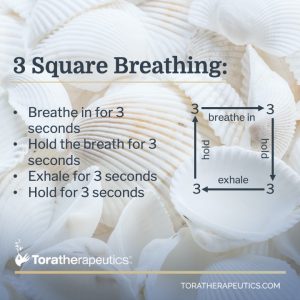Watch Your Breath
 In these recent installments, we have been speaking about the importance of healthy breathing practice. Here I will go into greater detail about how to improve our breathing, and thus, overall wellbeing – in body, mind, and spirit.
In these recent installments, we have been speaking about the importance of healthy breathing practice. Here I will go into greater detail about how to improve our breathing, and thus, overall wellbeing – in body, mind, and spirit.
Controlled breathing or conscious breathing is one of the very few ways a person can very easily, quickly, and efficiently calm the autonomic nervous system (ANS). By just becoming more mindful of our breathing habits, we can improve our health in many ways, including lowering blood pressure, improving asthma, helping heart conditions, improving mood, lowering resting heartbeat, etc. There are many different types of controlled breathing, some of which come from ancient traditions, including Judaism, and l”h, Hinduism, and Buddhism. In all cultures, however, it is understood that ‘breath,’ meaning ‘life,’ is the vehicle which infused the soul into the human. As we read in Genesis, “And He breathed into his nostrils, the breath (soul) of life.” In the works of the Kabbalah (Jewish Mysticism) and Ayurvedic medicine (pranayama), controlled breathing is considered a skill to develop for mystical insight, as well as wellness. Rabbi Yitzchok Ginsburgh teaches a kabbalistic format of conscious breathing called, “Chedvah Breathing.” This is where the numerical equivalent of each of the four letters of the word Chedvah (Ches=8, Dalet=4, Vov=6, Heh=5) is used as the length of each of the parts of the breath cycle (inhalation, hold, exhalation, hold). To see Rabbi Ginsburgh’s technique, click here: https://www.inner.org/
Having practiced conscious breathing techniques for many years (even for singing as a youngster), and learning the neurophysiology of breathing, I can now understand how a master in a religious tradition might use breath as a medium for insight as well as for health. Slowing down one’s breathing and controlling it (especially by preventing “over-breathing” or hyperventilation) can allow a person to become more present and calm, thus allowing him to gain greater mental acuity. Consider this fascinating Rashi from last week’s Torah portion: Moses comes to the children of Israel to share some great news. G-d is going to deliver them from slavery, take them out of Egypt, and bring them to the Promised Land! However, when Moses tells the Israelites, “they would not listen to Moses, because of their “kotzer ruach – anguish (literally, shortness of breath) and avodah kasha – hard labor.” Regarding the words, “kotzer ruach” Rashi translates it literally, to mean “short of breath.” He says, “If one has anguish, his breath comes in short gasps and he cannot draw long breaths.” If you will recall, when we discussed BASIC BREATHING FOR BEGINNERS as well as the BREATHING CONTEST™ we emphasized the importance of nasal breathing, which slows it down intentionally – especially on the exhale. When one uses conscious breathing, especially while counting, the counting also functions as a focal anchor and distraction. Thus, intrusive thoughts are swept away by the focus on breath counting. The BREATHING CONTEST™ is my signature form of conscious breathing. Here are a few more of my other favorite techniques for enhancing breathing for insight and wellness:
Square Breathing (or Box Breathing):
This is an isometric breathing exercise. Meaning, the elements of the breath cycle – inhalation, hold, exhalation, hold, are counted during the breathing practice, and in this case, all lengths are equal. For instance, a person may do a “3 Square Breathing” which would entail breathing in for 3 seconds, holding the breath for 3 seconds, exhaling for 3 seconds, and holding for 3 seconds. Then this cycle would be repeated. This helps with calming and grounding, developing breath control, and more.
“4-7-8” Breathing:
Popularized by Dr. Andrew Weil, 4-7-8 is a type of “breathing isometric” such as “Square Breathing,” and “Chedvah Breathing” above. In this exercise, you would breathe in through the nose to a count of 4, hold for a count of 7, exhale for 8 counts. This follows the important premise we have discussed regarding exhaling longer than inhaling to enhance the relaxation response.
Abdominal Breathing (or Belly Breathing):
There are many ways to develop your capacity for abdominal breathing. When breathing, higher in the chest region, we use auxiliary muscles, and don’t have the capacity to breathe in fully, since the upper part of the lungs is not as ample as the lower part. One way to determine if you are breathing properly is to hold to the lower part of your ribcage, pressing in, as you inhale through your nose. See if your hands come out a bit. Another way to verify if you are “belly breathing” is to put on hand on your chest and the other on your abdomen and see which moves when you breathe. If your chest moves more than your tummy, this is called, “vertical breathing” which is not optimal. A way to improve abdominal breathing is to lie down with a book on your stomach and note its rise and fall with your breath. See if you can challenge yourself to raise the book higher and higher or use a heavier book. This will strengthen your core and diaphragmatic muscles.
WATCH YOUR BREATH!
With Gratitude,
Rus Devorah



[…] your mouth is open and you’re over-breathing or hyperventilating. We’ve mentioned in this blog (HERE) that the optimal way to breathe is by inhaling through the […]